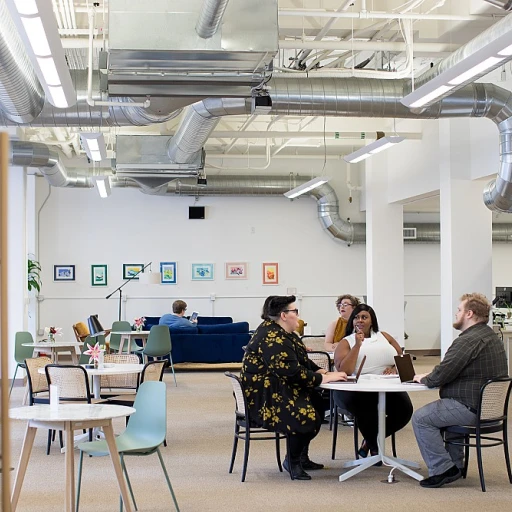
Understanding Digital Wayfinding
Exploring the Basics of Digital Wayfinding
Navigating through a complex environment has always been a challenge for visitors, whether in shopping malls, corporate buildings, or any large indoor space. Here’s where digital wayfinding comes in—a cutting-edge solution that combines wayfinding technology with digital signage to transform the visitor experience. Wayfinding systems today incorporate interactive maps, kiosks, and mobile solutions to provide real-time guidance. Digital wayfinding isn’t simply about putting up signs; it’s a comprehensive wayfinding solution that leverages advanced technology to simplify directions for users. It employs wayfinding kiosks and software to facilitate seamless navigation, making it easier for users to find points of interest indoors. Organizations across sectors are exploring this modern technology to enhance the visitor experience by making navigation more intuitive and engaging. Interactive wayfinding systems provide directions and information using interactive digital displays, maps, and even mobile apps. These systems are not limited to static information; they offer time updates and are equipped to help users efficiently, ultimately saving time and reducing frustration. The implementation of wayfinding digital systems is becoming increasingly common in places with high visitor traffic. By integrating wayfinding with interactive technologies, facilities can improve visitor satisfaction and operational efficiency. The future of digital wayfinding points to more dynamic and personalized experiences, potentially transforming how we move through complex environments. In the workplace, digital wayfinding can significantly impact how employees and visitors interact with their surroundings, as the workplace itself evolves. To further understand these dynamics, you might explore the evolution of the modern conference room, emphasizing the convergence of digital technology and physical spaces.The Role of Technology in Workplace Navigation
The Integration of Tech for Seamless Navigation
In today’s ever-evolving workspaces, technology plays a pivotal role in revolutionizing how individuals navigate workplace environments. Digital wayfinding solutions have emerged as a noteworthy development, leveraging the power of technology to assist users in finding directions with ease. Interactive kiosks, digital signage, and mobile applications are now utilizing real-time updates and wayfinding systems to provide an enhanced visitor experience. Advanced wayfinding technology, including indoor interactive maps and digital wayfinding software, offers remarkable assistance in bridging the gap between vast ecosystems within large facilities like shopping malls or office buildings. This kind of technology simplifies navigation by offering interactive digital platforms that are adaptive to users’ needs, ensuring swift and accurate directions. Moreover, the integration of wayfinding kiosks equipped with cutting-edge wayfinding solutions helps users identify points of interest within a facility while reducing the commonly experienced frustration with wayfinding signage. These digital tools not only benefit visitors but also streamline the efficiency of operations within such environments. The central role technology plays in workplace navigation cannot be overstated, as it facilitates seamless interaction and convenience. For businesses attempting to stay ahead in workforce management, investing in robust wayfinding systems is key. As detailed in the evolution of the modern conference room, integrating such technologies can greatly enhance the user experience within any workplace setting, ultimately leading to a more engaged and informed visitor base.Benefits of Digital Wayfinding in the Workplace
Revolutionizing Workplace Navigation with Digital Solutions
Implementing digital wayfinding in workplaces presents a multitude of benefits that greatly enhance the
Better Visitor Experience
Providing an exceptional experience for visitors is essential, and digital wayfinding plays a vital role in achieving this goal. With interactive maps and digital signage, visitors can effortlessly find directions, creating a seamless and stress-free visit. Digital kiosks situated at key points of interest facilitate smooth indoor navigation, minimizing confusion and providing real-time updates.
Increased Efficiency
The integration of wayfinding systems significantly improves efficiency by minimizing the time spent searching for locations. Users no longer need to rely on static wayfinding signage; instead, interactive digital solutions provide real-time information, dramatically reducing navigation time. These wayfinding solutions seamlessly adapt to changing environments and situations, ensuring users receive the most updated directions.
Enhancing Productivity and Connectivity
For employees, navigating with interactive wayfinding technology optimizes productivity by helping them efficiently reach different parts of large complexes or office spaces without delays. With workplace navigation transformed by technology, users gain access to precise, route-specific guidance, paving the way for smoother collaboration and connectivity within the facility.
Digital wayfinding also contributes to better use of space in corporate environments, aligning with modern workspace trends. Interested readers can explore how platforms enhance productivity in future workspaces. Adopting digital wayfinding means harnessing the power of time-saving, tech-driven solutions to create an environment where user experience is prioritized, and efficiency is paramount.
Challenges in Implementing Digital Wayfinding
Overcoming Obstacles in Digital Wayfinding Implementation
Implementing digital wayfinding systems isn't without its challenges. As organizations strive to create seamless navigation experiences, several hurdles often arise. Understanding these obstacles can help in anticipating solutions. One primary challenge is the integration with existing technology. Ensuring that digital signage and wayfinding software are compatible with current systems is crucial for a smooth transition. This might require investments in software updates or new installations, which can be both time-consuming and costly. User adoption is another hurdle. The success of a wayfinding solution depends on its acceptance by staff and visitors alike. Interactive maps and wayfinding kiosks should be user-friendly and intuitive, with clear instructions and real-time updates to aid unfamiliar users. Resistance to change can be mitigated through comprehensive training and by highlighting the benefits to the end-user. Maintenance is also a consideration. Digital wayfinding systems require regular updates and technical support to maintain accuracy and functionality. This is particularly crucial in dynamic environments such as shopping malls, where points of interest frequently change, necessitating constant updates to digital signage. Finally, ensuring accessibility is paramount. Digital solutions must cater to users with varying needs, providing features like audio assistance for the visually impaired or tactile feedback for those with mobility issues. While these challenges can seem daunting, addressing them systematically with innovative solutions will result in a more effective and user-centered navigation experience.Case Studies: Successful Digital Wayfinding Implementations
Real-World Implementations and Their Impact
In today's rapidly evolving work environments, the successful implementation of digital wayfinding solutions has become increasingly pivotal. Several industries have harnessed the power of wayfinding technology to enhance user experience and optimize navigation. By focusing on real-world examples, we can gain insights into the practical applications and advantages of these systems.
Shopping Malls and Entertainment Complexes
Shopping malls and large entertainment complexes have been at the forefront of adopting interactive wayfinding systems. These environments, known for their vast layouts and numerous points of interest, benefit significantly from digital signage and interactive kiosks. These technologies provide real-time directions and interactive maps to facilitate seamless navigation for visitors. As a result, customer satisfaction increases, and visitors are more likely to explore all areas of the facility.
Large Corporate Campuses
Corporate campuses have embraced digital wayfinding to improve the visitor experience and streamline internal navigation. By utilizing mobile applications and digital wayfinding kiosks, employees and visitors alike can locate meeting rooms and other facilities with ease. The ability to provide real-time updates ensures that users receive accurate information, reducing the time spent searching for destinations.
Healthcare Facilities
Healthcare facilities are another sector benefiting from wayfinding solutions. Hospitals, with their often-complex layouts, can present challenges for both patients and visitors. Implementing interactive digital signage and wayfinding software helps guide users efficiently, minimizing stress and enhancing their overall experience. The adoption of these systems has proven to alleviate confusion, aiding patients in finding departments or points of interest quickly.
Transportation Hubs
Airports and train stations serve as prime examples of wayfinding technology in action. With a constant flow of visitors requiring clear directions, interactive wayfinding systems play a vital role in ensuring smooth travel experiences. The use of digital signage and wayfinding software helps users find their paths without undue delays, ultimately ensuring efficient movement through these bustling hubs.
The successful implementation of these solutions highlights the versatility of wayfinding technology. As advancements continue, industries across the spectrum are likely to explore customized wayfinding systems that address unique needs, ultimately contributing to more efficient and user-friendly spaces.
Future Trends in Digital Wayfinding
Emerging Trends in Digital Wayfinding
As we look to the future, digital wayfinding is poised to become even more integral to workplace navigation. The evolution of wayfinding technology will continue to enhance the user experience, offering more interactive and personalized solutions. Here are some key trends to watch:
- Integration with Mobile Devices: Mobile technology will play a crucial role in digital wayfinding systems. Users will increasingly rely on their smartphones for real-time updates and interactive maps, allowing for seamless indoor navigation and enhanced visitor experience.
- Advanced Interactive Kiosks: Wayfinding kiosks will become more sophisticated, offering users interactive digital signage that provides detailed directions and information about points of interest. These kiosks will help visitors navigate complex environments like shopping malls and large corporate campuses.
- AI and Machine Learning: Artificial intelligence will be integrated into wayfinding solutions, enabling systems to learn from user behavior and provide more accurate and personalized navigation assistance. This will improve the efficiency of wayfinding software and enhance the overall user experience.
- Augmented Reality (AR): AR technology will transform wayfinding signage by overlaying digital directions onto the physical world. This interactive wayfinding approach will make navigation more intuitive and engaging for users.
- Seamless Integration with Other Technologies: Future wayfinding systems will integrate with other workplace technologies, such as IoT devices and smart building systems, to provide comprehensive navigation solutions that enhance efficiency and productivity.
These trends indicate that digital wayfinding will continue to evolve, offering innovative solutions that address the challenges discussed earlier. As technology advances, organizations will need to stay informed and adapt to these changes to provide the best possible navigation experience for their users.












